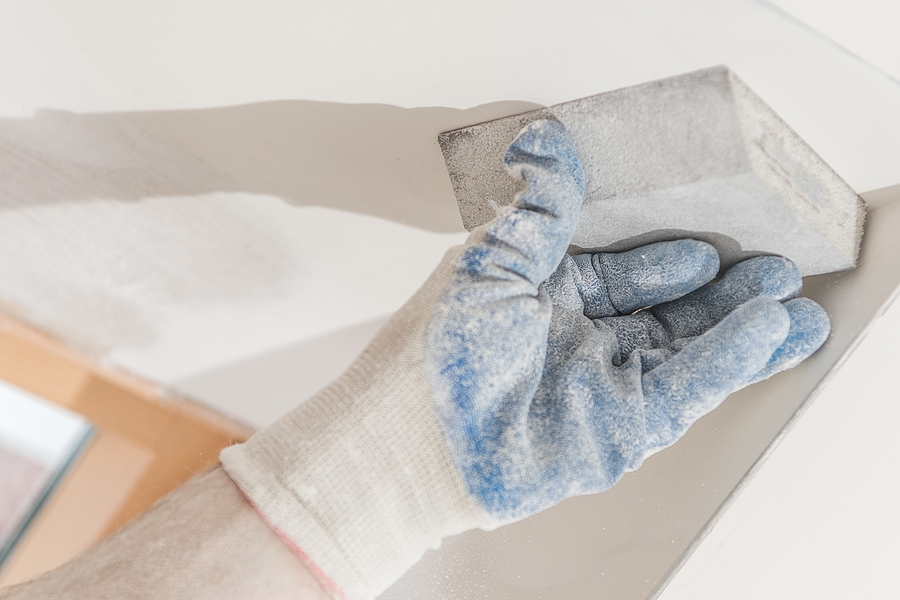Posted by Sandpaper America on Jul 22nd 2020
What You Need to Know When Prepping to Sand Drywall
Sanding drywall is not everyone’s first choice for DIY home construction and woodworking. It’s a messy, tedious, and often times, frustrating project for those not experienced or trained in drywall repair. But when it comes to achieving a flawless look for your home’s walls, there’s really no getting around it. Drywall sanding is critical to getting your walls to look their absolute best. The best method for easier drywall sanding is preparation and knowledge. Knowing a few important tips can mean the difference between a botched job and a great one.
Continue reading to learn some key advice for drywall sanding projects.

Be Sure to Use the Right Tools
The main tool you will be using for your drywall sanding project is a hand sander. These allow you to attach pre-cut sandpaper sheets in the grit of your choice. The higher the grit count, the finer the grit, which renders a smoother the finish in the end. Lower grit counts mean the grit is rougher, rendering a more course finish. For drywall, use a finer grit for a smooth finish. For best results, it is also recommended to use a drywall screen to catch loose sanding dust, rather than letting it accumulate on the sandpaper sheet.
A pole sander is another tool that should be used for drywall sanding projects. Rather than risking it with wobbly ladders and step stools, a pole sander extends in the hand so you can reach high spots and ceilings. It also allows you to sand large areas more efficiently. You can choose sand in long, length-wise strokes or short sideways strokes, all while keeping the head angled slightly to avoid denting the wall.
Another tool that is highly beneficial for drywall sanding is a sanding sponge. Use sanding sponges to sand corners and molding, if necessary. If you do not have a sanding sponge, you can simply fold a sanding sheet square in half to sand corners.
Be Sure to Use Good Craftsmanship
Technique is important when it comes to sanding any surface. For instance, drywall mud should be 100% thoroughly dried before any sanding can begin. Failure to do so will result in uneven surface conditions and visible cracking. Once you are ready to sand, be sure to use smooth, light, and gentle strokes to achieve an even finish. Using too much pressure or sanding excessively can damage new drywall. And avoid sanding in a straight line. These can result in visible depressions on the surface of the wall.
Always End With a Comprehensive Inspection
Even when you think you are all done and the walls are ready to be painted, there is still one more thing to do: a final inspection. Always be sure to do a comprehensive final inspection of all walls, corners, joints, and more. It is helpful to use a flashlight to look for imperfections and depressions on the surface. Mark any areas that require a touchup with light pencil, and then use a sanding sponge to smooth them out again. Deep gouges will require re-compounding, drying, and sanding.
Protect Yourself and Your Surroundings
Play it safe when sanding drywall by wearing the necessary protective gear, like eye goggles and ventilated face masks. Inhaling drywall dust can cause respiratory irritation and more. Also, lay drop cloths to protect floors and carpets from damage. Be sure to cover ventilation ducts to avoid sanding dust spreading through the rest of the house. Always thoroughly clean up after too, including vacuuming, wiping surfaces, and even purchasing a dust collecting system to reduce the amount of dust particles leftover after the sanding project is complete.
Sandpaper America
Call Sandpaper America at 1-800-860-SAND to purchase quality abrasives and sandpaper products online or over the phone! We have one of the largest inventories of sanding belts, sheets, discs, blocks, rolls, wolf heads, and much more, all at the most competitive prices online! Call 1-800-860-SAND to learn more about bulk ordering and online ordering of sandpaper products and abrasives, today.


